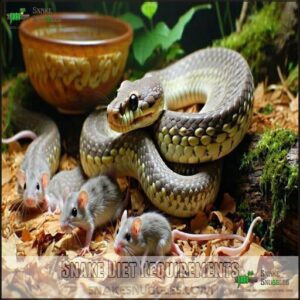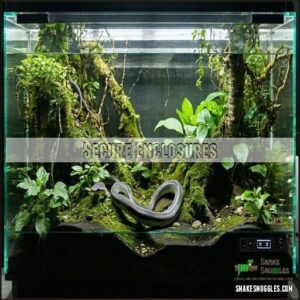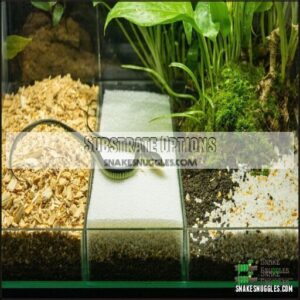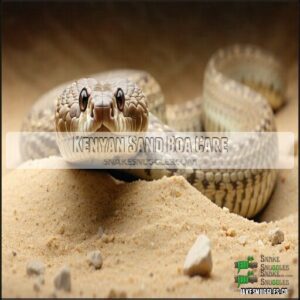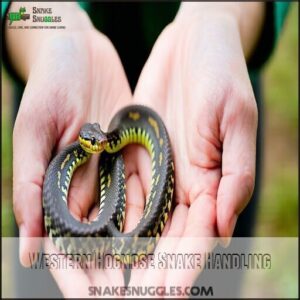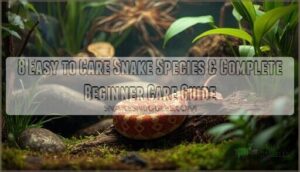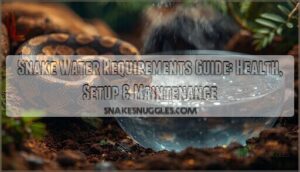This site is supported by our readers. We may earn a commission, at no cost to you, if you purchase through links.

They’re calm, non-venomous, and don’t make noise—no barking or meowing here! Corn snakes are beginner-friendly, with vibrant colors and manageable sizes.
Ball pythons are famously docile and love curling into a ball when shy. Rosy boas are slow-moving and easy to handle, perfect if you’re new to reptiles.
These snakes need simple setups: a secure tank, proper heat gradient, and a cozy hide. Plus, their diet is straightforward—mostly frozen-thawed rodents.
Ready for a snake that’s as chill as your favorite playlist? They offer a unique pet experience with their vibrant colors and manageable sizes.
Table Of Contents
- Key Takeaways
- Quiet Snake Species Overview
- Snake Size Considerations
- Snake Diet Requirements
- Habitat Setup Essentials
- Low Maintenance Snake Options
- Frequently Asked Questions (FAQs)
- Which snake is the most calm?
- What is the friendliest wild snake?
- What are the most cuddly snakes?
- Are there peaceful snakes?
- What are signs of stress in snakes?
- How to safely handle a shy snake?
- What enrichment activities benefit snakes at home?
- How often should snakes be handled?
- Can snakes recognize their owners over time?
- Conclusion
Key Takeaways
- You’ll love corn snakes for their vibrant colors, calm nature, and beginner-friendly care.
- Ball pythons are docile and easy to handle, making them perfect for quiet homes.
- Rosy boas are gentle, slow-moving, and thrive in small, simple enclosures.
- These snakes need secure tanks, proper heat gradients, and a diet of frozen-thawed rodents.
Quiet Snake Species Overview
If you’re looking for a pet snake that’s quiet and easy to care for, there are several great options to choose from.
Species like corn snakes, ball pythons, and rosy boas are calm, manageable, and perfect for beginners or experienced owners.
Corn Snake Characteristics
Corn snakes are beginner-friendly with their docile temperament and vibrant color morphs.
Corn snakes are perfect for beginners, offering vibrant colors, a calm demeanor, and easy care for stress-free companionship.
They shed two to three times yearly, so regular habitat checks are essential.
For enrichment, offer hiding spots like tissue boxes.
This snake species is perfect for calm, low-maintenance companionship, and they grow to a manageable size of 3–6 feet and need secure enclosures.
Ball Python Temperament
Ball pythons are calm snake species known for their docile temperament, making them one of the most gentle snake breeds.
Their beginner friendliness stems from their handling ease and ability to quickly adjust to enclosure acclimation.
A ball python’s steady disposition suits quiet homes, though they can be picky eaters, sometimes going weeks without a meal, which is completely normal, and this behavior is a part of their docile temperament.
Rosy Boa Behavior
The Rosy Boa is one of the most calm snake species, making it perfect for beginners. Its docile temperament means it doesn’t mind limited handling.
Rosy Boas are gentle and beginner-friendly, thriving with minimal handling and offering a calm, predictable companionship experience.
Known for its nocturnal activity, this snake thrives in small enclosures. Rosy boas need proper habitat setup to remain healthy.
- Unique burrowing habits make it fun to watch.
- Beautiful color morphs add variety to its appearance.
- Minimal temperament variations guarantee predictable, relaxed behavior.
Snake Size Considerations
When choosing a pet snake, it’s important to think about how big it might get as an adult.
Some species stay small, while others can grow several feet long, which affects the space and care they’ll need.
Small Snake Species
Small snake breeds, like the Kenyan Sand Boa and Rosy Boa, are perfect beginner-friendly snakes.
With their tiny size and calm demeanor, these docile small snakes thrive in apartment-sized enclosures.
They’re easy to handle and enjoy burrowing in the substrate.
| Snake Species | Adult Size | Temperament |
|---|---|---|
| Kenyan Sand Boa | 2–3 feet | Calm, burrowing |
| Rosy Boa | 17–34 inches | Beginner-friendly |
| Western Hognose | 2–4 feet | Gentle, docile |
Medium Sized Snakes
Medium-sized snakes strike a great balance for beginners.
Kingsnakes, like the California King Snake and Milk Snake, are manageable at 2–5 feet, have varied temperaments, and thrive with weekly handling.
Enclosure size is flexible but secure lids are key.
Their 10–20-year lifespan offers lasting companionship.
A suitable enclosure for Kingsnakes is a 20-30 gallon tank, allowing ample space for exploration.
- **Perfect for beginners wanting a docile pet.
- **Easy to handle and maintain.
- **Great size for safe interaction.
Large Snake Species
When considering large snake species, Boa Constrictors, Reticulated Pythons, Burmese Pythons, and even Anacondas may come to mind.
These impressive pet snakes require significant Size Housing and attention. Their calm snake temperament can surprise beginners, but secure snake enclosures are a must.
Here’s a quick comparison:
The key to keeping these snakes is understanding their unique characteristics and providing the appropriate care, including large enclosures that meet their specific needs.
Snake Diet Requirements
Feeding your pet snake correctly is essential for its health, and different species have specific dietary needs.
Some thrive on frozen-thawed rodents, while others might require live insects or specialized feeding approaches.
Frozen-Thawed Rodents
In regards to snake care, feeding frozen-thawed rodents is a staple. They’re packed with rodent nutritional value and safer than live prey.
Always follow thawing best practices to prevent illnesses. Choose size-appropriateness to match your snake’s needs.
Refusal solutions, like warming prey, can help picky eaters. Consider bulk frozen options for cost savings.
Proper storage recommendations support your snake’s diet consistently.
Live Insect Feeding
Insectivorous snakes like Kenyan sand boas often need live prey such as crickets or mealworms.
To guarantee proper snake nutrition, focus on insect gutloading and use nutritional supplements.
Feeding frequency varies; most species require insects 2–3 times weekly.
Consider species suitability when choosing live prey, and source insects from reputable providers to prevent introducing harmful parasites or diseases.
Many keepers purchase a live insect feeder to simplify feeding.
Specialized Feeding Needs
When dealing with picky eaters, ensuring the right prey size is key.
Some snakes prefer live prey, while others thrive on frozen options. Feeding frequency also varies, so stick to your species’ needs to avoid overfeeding.
Insectivorous snakes may benefit from dietary supplements. Understanding each snake’s specific diet requirements helps maintain their health and happiness.
Captive snakes often thrive on commercially available rodents, which is crucial for their overall health and happiness.
Habitat Setup Essentials
Setting up the right habitat is key to keeping your snake healthy and stress-free.
You’ll need a secure enclosure, proper temperature gradients, and a substrate that matches the species’ natural environment.
Secure Enclosures
A proper snake enclosure isn’t just a tank; it’s a fortress.
Escape prevention starts with lid security—tight-fitting lids and lock mechanisms keep your snake safe.
Use sturdy terrarium materials to avoid breaks.
Add hiding spots for comfort, but double-check they’re escapeproof.
For added security, consider specialized enclosure hardware.
Snakes are clever, so a well-thought-out snake tank setup guarantees they stay where they belong, making a secure environment essential.
Temperature Gradients
A proper temperature gradient is essential for your snake’s health.
Create a basking spot with a heat source on one side and a cool zone on the other.
Use thermostat control to regulate temperatures and guarantee gradient monitoring.
Snakes rely on thermal gradients for temperature regulation, so always check the enclosure to keep conditions stable and comfortable.
Substrate Options
Choosing the right snake substrate keeps your pet healthy and happy.
Consider these options based on snake enclosure requirements:
- Aspen bedding: Great for burrowing needs, easy to clean.
- Coconut husk: Retains substrate humidity, ideal for tropical species.
- Paper towels: Low cost, simple for frequent cleaning.
- Reptile carpet: Reusable, prevents mold but needs regular washing.
Match substrate to your snake’s habits and budget!
Low Maintenance Snake Options
If you’re looking for a snake that’s easy to care for, several species fit the bill. These low-maintenance options require minimal upkeep while still being fascinating to observe.
Kenyan Sand Boa Care
The Kenyan Sand Boa is a beginner-friendly, low-maintenance snake with a small size, making it perfect for compact spaces.
Its burrowing behavior is fascinating, as it loves sandy substrates.
Being nocturnal, it’s mostly active at night, so daytime interactions are minimal.
An insect diet, like crickets or mealworms, keeps it healthy.
These snakes thrive with simple care tips, ideal for new owners.
Western Hognose Snake Handling
Western Hognose snakes are fascinating pets with a calm temperament, although they may show defensive behaviors like bluff strikes.
Their docility improves with frequent, gentle handling.
Follow these tips:
- Handle in short, regular sessions to build trust.
- Approach from the side to reduce stress.
- Support the entire body for safety.
- Avoid handling after feeding to prevent issues.
Garter Snake Maintenance
Garter snakes are low-maintenance pets when you follow simple care steps.
Feed them a varied diet, including rodents and earthworms, on a supplement schedule. Spot-clean their snake enclosure daily and maintain moderate snake humidity. Use proper handling techniques to avoid stress.
Their tank size should be 15–20 gallons. Garter enrichment, like sturdy branches, keeps them active.
To maintain their health, provide UVB lighting for vitamin D3 synthesis.
| Aspect | Recommendation | Frequency |
|---|---|---|
| Shedding Frequency | 2–3 times yearly | Monitor shedding |
| Handling Techniques | Slow, supportive lifts | Weekly |
| Tank Size | 15–20 gallons | Always |
Frequently Asked Questions (FAQs)
Which snake is the most calm?
If calmness were a superpower, the Ball Python would wear the cape.
With its docile nature and gentle demeanor, it’s perfect for handling.
Just provide a cozy hide and watch it thrive stress-free.
What is the friendliest wild snake?
The gopher snake is often called the friendliest wild snake.
It’s non-venomous, calm when handled, and mimics rattlesnakes for defense.
Their curiosity and smooth scales make them approachable, even for beginners exploring wildlife.
What are the most cuddly snakes?
A ball python’s like the teddy bear of snakes—calm, slow-moving, and easy to handle.
Corn snakes and rosy boas are also great choices, offering docile temperaments and manageable sizes perfect for relaxed, cuddly interactions.
Are there peaceful snakes?
Yes, many snakes are peaceful.
Corn snakes, ball pythons, and rosy boas are great examples.
They’re docile, easy to handle, and rarely defensive, making them perfect companions if you’re seeking a calm, low-maintenance pet.
What are signs of stress in snakes?
If your snake hides excessively, refuses food, remains defensive, or stays in one spot for too long, it’s likely stressed.
Changes in shedding, rapid breathing, or frequent attempts to escape also signal discomfort.
How to safely handle a shy snake?
Imagine slowly gaining a shy friend’s trust.
Approach your snake from the side, avoid sudden movements, and support its body securely.
Handle gently and briefly at first, letting it feel safe in your hands.
What enrichment activities benefit snakes at home?
Provide hiding spots like cork bark or tissue boxes, climbing branches, and tunnels for exploration.
Rotate items to keep things fresh. Even simple changes, like rearranging decor, can stimulate curiosity and encourage natural behaviors.
How often should snakes be handled?
Handle your snake 1–3 times a week to build trust and keep it comfortable with interaction.
Avoid handling during shedding or right after feeding, as it can stress them or disrupt digestion.
Can snakes recognize their owners over time?
Like a familiar rhythm, some snakes may associate your scent or presence with safety over time.
While they don’t bond like dogs, consistent, gentle handling helps them recognize you as non-threatening.
Conclusion
Owning a quiet snake species for homes is like having the most low-maintenance roommate ever.
Corn snakes, ball pythons, and rosy boas are calm, easy to care for, and don’t demand much space.
With simple diets and basic habitat needs, they’re perfect for beginners or experienced reptile lovers.
Their vibrant colors and manageable sizes make them enjoyable to watch and handle.
If you’re ready for a unique, peaceful pet, these snakes are an excellent choice.
- http://www.discoveranimals.org/pets/petanimal/ball-python
- https://www.semanticscholar.org/paper/Gut-loading-to-enhance-the-nutrient-content-of-as-A-Finke/547bc5ed12bbe58fdbef96156973945eae152c12
- https://www.facebook.com/Ingleside-Animal-Hospital-118627978258/
- https://nhmu.utah.edu/
- http://www.bonnevilleshorelinetrail.org/



